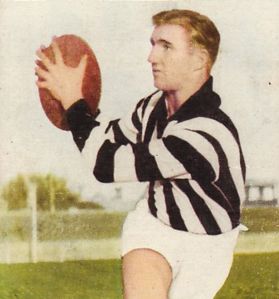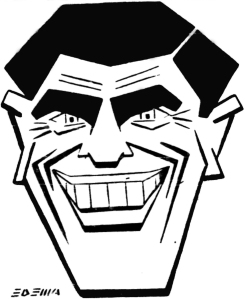Posts Tagged ‘Collingwood Football Club’
They All Played Their Part
Jack Hamilton
Debut – 1948
Retired – 1957
Games – 154
Goals – 16
Missed 1953 Grand Final due to injury
Jack was one of the best full-backs that Collingwood has had since World War II, he unluckily missed the 1953 Grand Final after breaking his scaphoid bone in the round 14 clash against Geelong, four weeks before the start of the finals.
Hamilton was a tough and ruthless fitness fanatic who was one of the first players of his era to lift weights as a way of improving strength.
He later went on to a career in football administration, becoming chief commissioner of the VFL in 1984. He was killed in a car accident in May 1990, the year in which Collingwood would finally break their 32 year premiership drought.
Maurice Dunstan
Debut – 1949
Retired – 1954
Games – 72
Goals – 118
‘Mocha’ played in the forward line for most of the 1953 season, although he was said to be quite an unreliable shot for goal. He scored 22 goals for the season out missed the finals due to an injury sustained in the final home & away match against Footscray. He also missed rounds 2- 5 with injury that season.
Maurice Dunstan is perhaps best known for having a son, Ian, who played 172 games for Footscray.
Jack Hickey
Debut – 1951
Retired – 1956
Games – 72
Goals – 15
Jack Hickey was dropped from the side after the semi-final win over Geelong after playing 17 games for the 53 season.
Frank Tuck
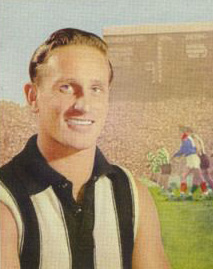 Debut – 1950
Debut – 1950
Retired – 1959
Games – 131
Goals – 34
Captain – 1958-59
Dave Little
Debut – 1953
Retired – 1955
Games – 10
Goals – 1
Dave Little came to Collingwood from Korrumburra at the beginning of the 1953 season with lots of hype that he never lived up to. He played only 3 games in 1953.
Peter Lucas
Debut – 1949
Retired – 1959
Games – 177
Goals – 1
Peter Lucas missed both the 1952 & 53 Grand Finals through injury. He was a fine half-back-flanker who could block the most talented forwards in the VFL. He was not very flamboyant but he was consistent. He played in the 1958 premiership team.
Kevin Clarke
Debut – 1953
Retired – 1954
Games – 18
Goals – 7
Bill Tebble
Debut – 1950
Retired – 1953
Games – 57
Goals – 8
Was a defender who played either back-pocket or centre-half-back. Kicked all his career goals in 1953 when he was shifted to the forward line in Bill Twomey’s absence early in the season.
Kevin Flint
Debut – 1952
Retired – 1953
Games – 4
Goals – 3
Tom Tarrant
Debut – 1953
Retired – 1954
Games – 7
Goals – 1
Pat Milburn
Debut – 1953
Games – 6
Goals – 3
Fred West
Debut – 1950
Retired – 1953
Games – 17
Goals – 4
Keith Bromage
Debut – 1953
Retired – 1961
Games With Collingwood (1953-56) – 28
Games With Fitzroy (1958-61) – 41
Total Games – 69
Goals for Collingwood – 30
Goals for Fitzroy – 48
The youngest player to ever play league football when he debuted in round 17 against Richmond. He was just 15 years of age.
Barry Taylor
Only game was the 1953 ANZAC Exhibition Match against Fitzroy. There is no evidence of him ever playing a senior match.
1953 Copeland Trophy
September 30, 1953…
In 1953 Bob Rose won his fourth and final Copeland Trophy as Collingwood’s best & fairest player, a feat only surpassed by Nathan Buckley who has won the award six times, and Len Thompson who has won the award five times. In fact 1953 was the third time in a row that Rose had won the Copeland, something that only he, Phonse Kyne , Buckley and Dane Swan have achieved for Collingwood.
Another member of the Magpies Hall of Fame, Neil Mann finished second in the award on 35 1/2 votes to Rose’s 41, following up on his great third placing in the Brownlow Medal of that year. Des Healey finished third on 19 1/2 votes to cap off a brilliant season by him where he was judged by many observers to have been best on ground in Collingwood’s Grand Final victory.
Copeland Trophy – Bob Rose
R. T. Rush Trophy – Neil Mann
J. J. Joyce Trophy – Des Healey
After winning the award Bob was kept busy in his sports store by lots of congratulatory visits and phone calls from members of the Magpie Army. (1) He said that he was very proud to win the Copeland Trophy and graciously thanked his team mates for helping him to win it. He also thanked Collingwood’s supporters for their generosity and the club for their liberal treatment of the players. (2)
________________________________________________________________________
1 – The Argus – October 1, 1953 – page 3
2 – The Argus – October 1, 1953 – page 3
The 1953 Brownlow Medal
September 3, 1953…
A Collingwood player did not win the Brownlow Medal in 1953, that award went to Essendon skipper Bill Hutchinson, but two of the Magpies’ greats filled the second and third placings. Bob Rose capped off a brilliant season by taking second place in the award on 22 votes, just four votes behind Hutchinson, whilst Neil Mann finished third on 17 votes. The Argus summarised that Hutchinson was aided by the fact that Collingwood players polled so heavily and took votes off each other. (1) Both Rose and Mann were judged best on ground five times apiece, whilst the Magpies’ took the umpire’s three votes in 16 of the 17 matches where votes were awarded. (2) Sadly skipper Lou Richards polled no votes at all and was the only one of the VFL‘s skippers to not score a single vote on the night. (3) Overall it was still a great result for the Magpies.
In other news
3AW recorded the count and rebroadcast parts of it on their radio station to their listeners, which was a first.(4)
Results
- W. Hutchinson (Essendon) – 26 votes
- R. Rose (Collingwood) – 22 votes
- N. Mann (Collingwood – 17 votes
- B. Smith (Geelong) – 16 votes
- R. Clegg (South Melbourne) – 14 votes (5)
____________________________________________________________________________
1 – The Argus – Thursday September 3, 1953 – page 32
2 – The Argus – Thursday September 3, 1953 – page 32
3 – The Age – Thursday September 3, 1953 – page 9
5 – The Argus – Thursday September 3, 1953 – page 1
Round 10 – Essendon Vs Collingwood
The headline at the Argus summed up the result of this clash very nicely: “Don ‘Tornado’ Hits Collingwood”, as Essendon defeated the Magpies by 28 points, thanks to a 6 goal haul by John Coleman.
Des Healey
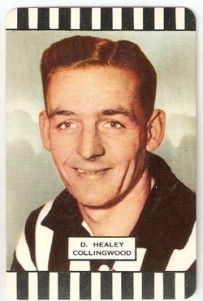 Debut – 1948
Debut – 1948
Retired – 1955
Games – 149
Goals – 27
1955 Copeland Trophy
1951 & 1954 R. T. Rush Trophy
1953 J. J. Joyce Trophy
Seconds Best and Fairest: 1947
Interstate Representative: 1949, 1953 (carnival)
All-Australian – 1953
Coach under 19s – 1972-77
Member of Collingwood’s Hall of Fame (Inducted 2006)
Des Healey was a brilliant and attacking wingman whom both Phonse Kyne and Lou Richards regarded as the best winger Collingwood had ever produced, whilst Essendon legend John Coleman described Healey as the best wingman he had ever seen in the game. Coleman praised him by saying, “He is clever, has that wonderful tenacity of all good Collingwood players, and is tireless.” His teammate Bill Twomey Jr. said that Healey was the cleverest player he had ever seen in one on one duels, whilst Bob Rose said that Healey was a top class player who had everything. Richmond’s duel Brownlow Medalist Roy Wright called Des the gamest player he had ever seen and that he had a lot of courage for someone who was just 5’6″. “If he were a big man he would kill someone the way he tears through packs” Wright said. Along with fellow left-footers Bill Twomey and Thorold Merrett Healey was a part of one of the best centrelines of the era.
The tenacious Healey was small and fast and a great stab-kick off his left boot. He also possessed a safe pair of hands as he was a great mark. He showed dazzling speed in the way he cashed the ball and could keep control of it with uncanny ability. His evasive skills were superb. Healey worked long and hard perfecting his talent. He often spent extra nights alone on the training track twisting and turning around imaginary opponents at top pace. His unrivalled commitment was inspiration for all.
1953 was a stand out year for Healey, as he won All-Australian selection and was judged by many observers to be best on ground in Collingwood’s premiership win. He was third in the Copeland Trophy behind Bob Rose and Neil Mann.
Unfortunately today Healey is most well-known for the last game in which he played, the 1955 Grand Final loss to Melbourne. In one of the most talked about incidents in Grand Final history and with three minutes to go in the match, Healey collided with Melbourne’s Frank ‘Bluey’ Adams who had just run onto the ground from the bench. Healey, who had been the Magpie’s best player to that point, had his nose broken, skull fractured and was severely concussed. Despite winning the Copeland Trophy that year he never played another game saying ‘I could not stand another blow like that. He was just 27.
Healey was also an outstanding cricketer who in the 1953-54 season was a part of Collingwood’s first grade district cricket team. In the 1952-53 season he was a part of the Magpies’ second XI team where he topped the batting averages and won the club championship. He top scored in the final match of the season with 92 runs against South Melbourne. Two years earlier both Healey and Merrett were team-mates in Collingwood’s 1951 Third XI team that won the cricket final against Prahran. They put on a 151 run partnership to set up their victory, with Healey scoring a century and Merrett making 51.
In the late 70s Des spent six years as coach of Collingwood’s under 19 team, nuturing young talent such as Peter Daicos. Healey passed away in 2009 aged 81.
____________________________________________________________
Acknowledgements
- Roberts. M & McFarlane. G -The Official Collingwood Illustrated Encyclopedia – Updated Edition – 2010 The Slattery Media Group
- Holmesby R & Main J. – The Encyclopedia Of AFL Footballers – Seventh Edition – 2007 Bas Publishing
- Main. J – When It Matters Most – 2006 Bas Publishing
- Collingwood Football Club Website – http://www.afl.com.au/Season2007/News/NewsArticle/tabid/5586/Default.aspx?newsId=7022
- Carlyon. G – Gordon Carlyon’s Scrapbook Number 2 – 2002 Gordon Carlyon
- Roberts. M – A Century Of The Best – The Stories of Collingwood’s Favourite Sons – 1991 Collingwood Football Club
Lou Richards
Debut – 1941
Retired – 1955
Games – 250
Goals – 423
Captain – 1952-1955
Collingwood’s Leading Goalkicker – 1944, 1948, 1950
R.T. Rush Trophy – 1947, 1950 (Runner Up Best & Fairest)
J.J. Joyce Trophy – 1951 (3rd Best & Fairest)
Member of Collingwood’s Hall of Fame (Inducted 2004)
Out of all the champions who have donned the famous black & white jumper Lewis Thomas Charles Richards is perhaps the most famous of all. Unfortunately it is for his deeds off the ground, as football’s first multi-media star that Lou is remembered rather than his great contributions to the Magpies as a player and premiership captain. While Lou never won a Copeland Trophy he was placed three times, coming runner-up in 1947 and 1950 and third in 1951. He also led Collingwood’s goalkicking on three occasions in 1944, 48 and 50. In 1947 he was named the Herald’s Player of the Year. In that year he also polled the most Brownlow Medal votes of all the Magpies (10) to finish 14th. Phonse Kyne who won that year’s Copeland Trophy finished a further three votes behind Lou, as did teammates Ray Horwood and Ray Stokes. With the exception of the 1953 premiership year in which he did not poll a single vote, Lou was usually one of Collingwood’s best polling players on Brownlow night.
While Lou was an immensely courageous rover with a ton of cheek, who was rugged, tough and determined. He also was ferociously competitive and had a fierce will to win. In 1951 on Phonse Kynes’s retirement as a player he forced his brother Ron to nominate him for the captaincy of the Magpies, but was overwhelmingly rejected in favour of Gordon Hocking. Neil Mann was appointed vice-captain to Hocking, something which really annoyed Lou as he did not have the experience of Richards. However rather than dwell on this misfortune he decided to reflect on what he perceived as his biggest flaw, his open criticism of his teammates, both on and off the field. Lou decided to change his style and became encouraging rather than critical and by 1952 he was appointed captain after filling in for Hocking and Mann on occasion in 1951. Des Healey claimed Lou was the best captain he had played under saying that “He was a magnificent team man and a real great Collingwood player – he culd almost win matches for Collingwood on his own by getting the other players in. Thorold Merrett claimed, “He was always firing you up, telling you to get up if you were hurt and urging you from start to finish.” whilst his deputy Neil Mann said “Louie was a terrific captain, always giving you lots of encouragement.” Bob Rose rated Lou as the best rover of his era, alongside Essendon’s Bill Hutchison and Fitzroy’s Alan Ruthven. Lou’s greatest triumph was leading the team to premiership glory in 1953.
 After retiring from the game in 1955 Lou was given two options. The first was to coach Collingwood’s seconds with a view to becoming senior coach some time in the future, while the second was to join the media and to write articles for the Argus. Deferring the decision to his beloved wife Edna, Lou decided to set himself on the road to multi-media mega-stardom by refusing the coaching job and writing for the Argus. Despite his reservations Lou proved a natural, which shouldn’t have surprised anyone since during his playing career he was a media darling, giving extensive interviews for all of Melbourne’s daily newspapers on occasions. He was also a favourite of newspaper cartoonists such as The Age’s Sam Wells and The Herald’s WEG, who often depict him as a loud-mouthed chimpanzee. He would go onto being the game’s greatest media personality on radio, television and the newspapers.
After retiring from the game in 1955 Lou was given two options. The first was to coach Collingwood’s seconds with a view to becoming senior coach some time in the future, while the second was to join the media and to write articles for the Argus. Deferring the decision to his beloved wife Edna, Lou decided to set himself on the road to multi-media mega-stardom by refusing the coaching job and writing for the Argus. Despite his reservations Lou proved a natural, which shouldn’t have surprised anyone since during his playing career he was a media darling, giving extensive interviews for all of Melbourne’s daily newspapers on occasions. He was also a favourite of newspaper cartoonists such as The Age’s Sam Wells and The Herald’s WEG, who often depict him as a loud-mouthed chimpanzee. He would go onto being the game’s greatest media personality on radio, television and the newspapers.
In Collingwood’s 2010 premiership year Lou was once again in the headlines over the AFL’s refusal to elevate him to Legend status in the AFL’s Hall of Fame. The AFL argued that due to their rules which states Legends must be players and coaches at the “very pinnacle” of the game onfield, despite being one of the few to have captained Collingwood to a premiership and despite being the most-loved and greatest character that the game has produced.
___________________________________________________________
Acknowledgements
- Roberts. M & McFarlane. G -The Official Collingwood Illustrated Encyclopedia – Updated Edition – 2010 The Slattery Media Group
- Holmesby R & Main J. – The Encyclopedia Of AFL Footballers – Seventh Edition – 2007 Bas Publishing
- Richards L. & Phillips S.- The Kiss Of Death – 1989
- Stevens M. – Lou Richards rejects AFL Hall of Fame offer – http://www.heraldsun.com.au/news/its-all-or-nothing/story-0-1225713271416
- Carlyon. G – Gordon Carlyon’s Scrapbook Number 2 – 2002 Gordon Carlyon
- Roberts. M – A Century Of The Best – The Stories of Collingwood’s Favourite Sons – 1991 Collingwood Football Club
Phonse Kyne
As A Player
Played – 1934-1944 1946-1950
Games- 245
Goals – 237
Captain- 1942, 1946-1949
Copeland Trophy – 1946, 1947, 1948
Runner Up Copeland Trophy – 1938, 1939, 1949
3rd Copeland Trophy – 1936
Victorian Representative – 11 times
Captain Victoria – 1947
As Coach
1950-1963
Premiers – 1953, 1958
Member of Collingwood‘s Hall of Fame
Member of Collingwood Team of the Century
Phonse Kyne is one of Collingwood’s all-time greatest players but it is as the coach of the 1953 and ’58 premierships that he is most fondly remembered. He is one of only four players to have won the Copeland Trophy three times in a row and was runner-up on another three occasions. He played as centre-half forward in the 1935 & 36 premiership sides but is most remembered as one of the best ruckmen of his era. He was a clever palmer of the ball who used his body well to achieve front position, Lou Richards once said that all the rover had to do was to give Kyne a call and the ball would be waiting for him.
It is also worth noting that his coaching career started in controversial circumstances. He was seen as the logical successor to the legendary Jock McHale but the club appointed Bervyn Woods instead. This move caused an uproar at Collingwood, with the club going to war over the issue. It seems that the appointment of Woods was political, with president Harry Curtis having long promised the senior coaching position to the long time seconds coach. A special squad of police had to be called in to control a rowdy mob of supporters at a meeting by the committee to resolve the issue at the Collingwood Town Hall. Woods, seeing the damage that his appointment had caused the famous club graciously offered his resignation.
As a coach he was very much in the mould of his mentor, the great Jock McHale, and openly based his coaching methods and approach to the game on those of the his predecessor. Kyne’s first match as coach was on April 22nd 1950. His 272 games as coach is the second most by a Collingwood player with the Magpies winning 161 of those games, including premierships in 1953 and 1958. According to Collingwood folklore Phonse was so nervous before the ’53 Grand Final that he made use of a kangaroo paw lucky charm that one of his friends had given him. Lou Richards, who was the captain of the 1953 Premiership team said that one of Kyne’s great traits was that he would never publicly berate his players but “If Phonse had something to say – and he had plenty to say on occasions – he drew the player aside and gave it to him man to man.”
Away from the football field has was also a gentle man who was respected by everyone who knew him. Lou Richards said that Kyne was… “a loyal and lasting friend who would never have a word against any of his teammates or players.” whilst Richmond’s Jack Dyer, one of Kyne’s fiercest opponents from his playing days, paid his respect to Phonse when he said “He was Collingwood first, second, third and forever. But you could always shake his hand and have a beer with him after the game.” The only flaw may have been his tendency to deal with the disappointment of defeat by coming home from the game and then refusing dinner, going straight to bed and pulling the sheets over his head! However Phonse never lost his temper even in these difficult circumstances.
Phonse’s coaching career ended as it began, in controversy due to the political turmoil within the Club. In 1963 Tom Sherrin and Jack Galbally were at war over the presidency of the Club, with Sherrin saying that if he won the vote he would endorse Bob Rose as the next Collingwood coach. Phonse claimed that he had the full-support of the entire board with the exception of Sherrin, and said that the players were supportive of him and of Galbally. This move infuriated Collingwood captain Murray Weideman who had been trying to keep the players out of the bitter political turmoil. As a result Weideman organised a team meeting to debate Phonse’s statement, and to guage the feeling amongst the rest of the playing group. The general consensus Weideman said, was that whilst Phonse Kyne may have been the current coach, the players wanted him replaced by Bob Rose. The team struggled through 1963, finishing eighth, failing to make the finals for the third successive year. The players, who had thrown their weight behind the successful Sherrin bid for the presidency, got their wish as Phonse was sacked as coach at the end of the season and Bob Rose was appointed for 1964. It was a sad end to the coaching career of one of the most highly regarded men in Australian football and one of the great servants of the Collingwood Football Club.
_________________________________
Acknowledgements
- Roberts. M & McFarlane. G -The Official Collingwood Illustrated Encyclopedia – Updated Edition – 2010 The Slattery Media Group
- Holmesby R & Main J. – The Encyclopedia Of AFL Footballers – Seventh Edition – 2007 Bas Publishing
- Roberts. M – A Century Of The Best – The Stories of Collingwood’s Favourite Sons – 1991 Collingwood Football Club
- Phonse Kyne’s Facebook page – http://www.facebook.com/pages/Phonse-Kyne/112924315384332
The Opposition – Footscray
 Footscray in 1953 were on the cusp of premiership success. This was the year they won their first ever final, when they defeated Essendon in the semi-final by 8 points. They reached the preliminary final which they lost to Geelong by 26 points. It would be another year before the Bulldogs would finally taste premiership glory by winning their only Grand Final.
Footscray in 1953 were on the cusp of premiership success. This was the year they won their first ever final, when they defeated Essendon in the semi-final by 8 points. They reached the preliminary final which they lost to Geelong by 26 points. It would be another year before the Bulldogs would finally taste premiership glory by winning their only Grand Final.
Footscray were captained and coached by Charlie Sutton. He debuted with the club in 1942 and played 173 games in a career that lasted 12 years. (He did not play between 1943-1945) He became captain/coach of the Bulldogs in 1951, a year after he won the best & fairest award which would subsequently be named after him. He would remain captain until his retirement as a player in 1955 and stay as coach until he was unceremoniously dumped midway through the 1957 season, when Ted Whitten took over. He is also a member of Footscray’s team of the century. He is a legend of the Footscray Football Club.
Ruckman Harvey Stevens won Footscrays’ best & fairest award in 1953. Two weeks prior to the start of the 1953 season Stevens was dumped by Collingwood and was fortunately picked up by the Bulldogs just prior to round 3. Stevens played VFL footy for 10 years, with 5 seasons at Collingwood where he played 55 games, and 5 at Footscray where he played 72 games. He played in Collingwood’s losing 1952 Grand Final side, where he was tried without success at full-forward, even though he had never played in that position before. Many feel that he was made the scapegoat for that loss and despite performing well in the 1953 preseason he was dumped from the team before the start of the new season. Stevens became a member of the Bulldogs’ 1954 premiership side and captained Footscray in 1957.
 The most famous Bulldog of all was a member of the 1953 side. 1953 was the 3rd VFL season for the legendary Ted Whitten. ‘E.J’ had played just 29 games prior to 1953. To many people he was the embodiment of everything Footscray, he captained the club from 1957 until his retirement as a player in 1970. Teddy also coached the club from July 1957 until 1966, when his predecessor Charlie Sutton took over the helm, and again from 1969 until 1972, when Collingwood’s greatest ever player Bob Rose took over the coaching role. Whitten won the Bulldogs’ best and fairest in 1954, 57, 58, 59 and 61 and was their leading goal kicker in 1961, 62, 64 and 68. He is the captain of both the Western Bulldogs‘ team of the century and AFL team of the century. Like Sutton he is a legend of the Western Bulldogs Football Club.
The most famous Bulldog of all was a member of the 1953 side. 1953 was the 3rd VFL season for the legendary Ted Whitten. ‘E.J’ had played just 29 games prior to 1953. To many people he was the embodiment of everything Footscray, he captained the club from 1957 until his retirement as a player in 1970. Teddy also coached the club from July 1957 until 1966, when his predecessor Charlie Sutton took over the helm, and again from 1969 until 1972, when Collingwood’s greatest ever player Bob Rose took over the coaching role. Whitten won the Bulldogs’ best and fairest in 1954, 57, 58, 59 and 61 and was their leading goal kicker in 1961, 62, 64 and 68. He is the captain of both the Western Bulldogs‘ team of the century and AFL team of the century. Like Sutton he is a legend of the Western Bulldogs Football Club.
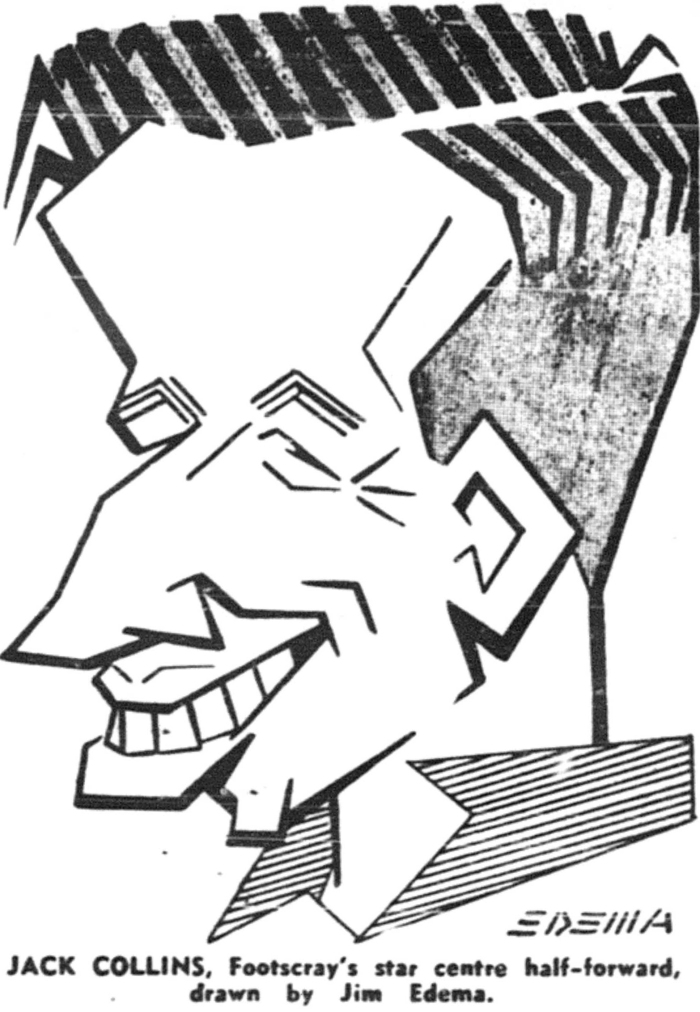 In 1953 the leading goal kicker for Footscray was Jack Collins who kicked 50 goals for the season. Collins won the best & fairest award for the Bulldogs in 1951 and 52. His 1953 season is perhaps remembered mostly for the controversy that occurred in the final round of the home & away season when he and Collingwood’s Frank Tuck clashed which caused both players to be suspended for the finals series. Collins played 154 games for Footscray over 9 seasons and kicked 385 career goals.
In 1953 the leading goal kicker for Footscray was Jack Collins who kicked 50 goals for the season. Collins won the best & fairest award for the Bulldogs in 1951 and 52. His 1953 season is perhaps remembered mostly for the controversy that occurred in the final round of the home & away season when he and Collingwood’s Frank Tuck clashed which caused both players to be suspended for the finals series. Collins played 154 games for Footscray over 9 seasons and kicked 385 career goals.
Peter Box was another of Footscray’s top players of the 1950s. He debuted in 1951 but missed the entire 1952 season through injury. In 1956 he won the Brownlow Medal after winning Footscray’s best & fairest in 1955. Don Ross the 1956 Footscray best & fairest was playing his second season in 1953.
The Footscray backline of 1953 also featured some of their all-time great players including Wally Donald and Herb Henderson. The Bulldogs conceded only 959 points for the season, the lowest in the VFL history to that date.
1953 Lightning Premiership
Tuesday June 2 1953
The 1953 Lightning Premiership was an odd and meaningless diversion played in the middle of the premiership season. It was a knockout competition featuring the 12 VFL teams, played at the MCG on Tuesday June 2. Each match consisted of a two quarters, with the winner progressing to the next round. The only teams who fielded their almost full-squads seemed to be those dwelling on the bottom half of the VFL ladder, with cellar dwellers Richmond defeating St Kilda in the final.
In their match the Magpies played Footscray. Neither team was at full strength but the Bulldogs advanced to the quarter-finals by beating Collingwood easily. The Magpies did not score a goal for the game. Thorold Merrett was Collingwood’s best player on the wing, but his good work was brought undone due to the Magpies’ poor forward work. (1)
Teams |
Score |
|
Footscray |
3.2.20 |
| Collingwood |
0.2.2 |
In another first round match Essendon defeated Geelong.
Footscray encountered eventual Lightning Premiership winner Richmond in the next round, which they lost by five points, while Essendon would lose to St Kilda in a semi-final.
The Magpies and the Bulldogs would encounter each other again in four days time in what would be a classic match at the Western Oval. That match would be for premiership points and show that both of these teams would almost be ready for the monumental challenge that was Geelong.
___________________________________________________
Footnote
- The Herald – Tuesday June 2 1953 – page 16


